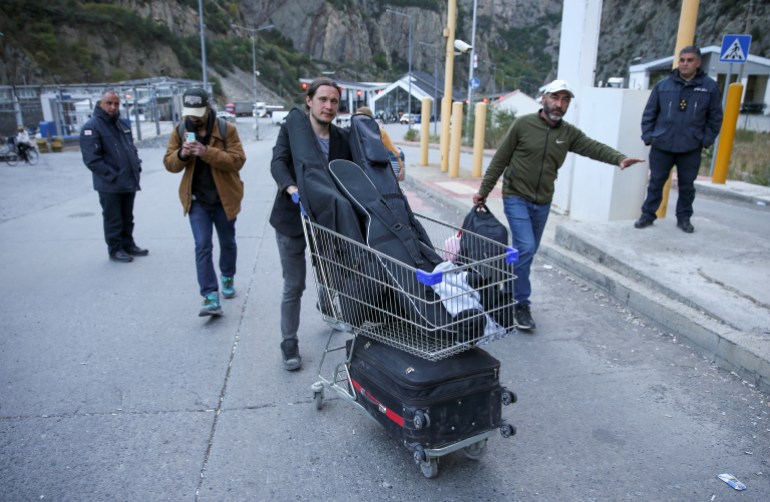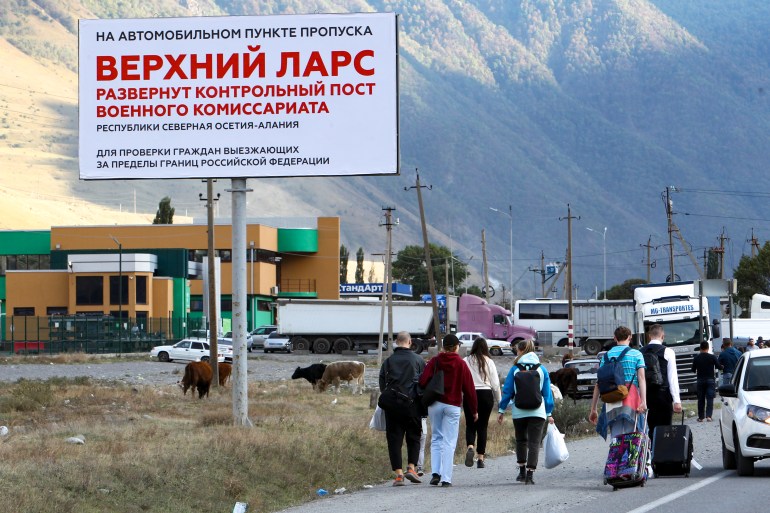What travel restrictions is the EU imposing on Russians? | Russia-Ukraine war News
Before the Ukraine war began, the European Union was a popular port of call for Russians.
Under the terms of a 2007 visa agreement brokered when ties were significantly warmer, they enjoyed preferential access to the bloc and could visit easily for tourism or business.
But since February 24, when Russia launched its invasion, border controls tightened as the Kremlin’s relations with Western nations sank to post-Cold War lows.
Within days, the EU banned flights to and from Russia.
As the war dragged on, the bloc went further.
In early September, it suspended the 2007 visa deal.
The cost of an individual visa rose from 35 euros ($34) to 80 euros ($77), and Russians would now be made to provide additional documents and face longer processing times.
On September 19, the Baltic States and Poland closed their doors to Russian tourists, and condemned Finland for not joining them. Days earlier, their governments had released a statement citing security concerns.
“There are persons coming with the aim of undermining the security of our countries, insofar as three-fourths of Russian citizens support Russia’s war of aggression in Ukraine,” it said.
On September 21, Russian President Vladimir Putin announced a partial mobilisation, a move which sent thousands fearing the draft rushing to the borders to escape.
Most headed to Georgia and Kazakhstan, but some travelled towards Finland.
On September 30, Finland also banned Russian tourists, closing off the last direct route into the bloc.
The moves do not amount to an outright ban, but reflect the depth of deterioration in EU-Russia relations.
They also highlight divisions within the bloc – while those near Russia have taken action, others such as Germany and France say blanket restrictions feed into Moscow’s anti-Western narrative and risk estranging future generations of Russians.
Here is what you need to know:
What are the current EU-wide rules?
The EU imposed flight bans on February 27, meaning Russians would have to reach the bloc via third countries.
As the conflict intensified, discussions over further action became mired in disagreement.
More than six months later, EU leaders settled on suspending an historic visa facilitation agreement with Moscow, ending 15 years of privileged access for Russian nationals.
The 2007 visa deal had been agreed on when both sides expressed hope that smoother travel would contribute to a “steady development” of economic, humanitarian, cultural and scientific ties.
The visa application fee has risen and Russians must now produce additional documentation. The rules on issuing visas are tighter and processing times are longer.
However, Russian nationals can still technically access the EU via third countries and get 90-day short-stay visas, pending successful applications. They can also move freely within the majority of the Schengen Area once inside it.
Natia Seskuria, a Russia expert and associate fellow at the United Kingdom-based Royal United Services Institute for Defence and Security Studies (RUSI) think-tank, told Al Jazeera the suspension of the 2007 agreement had “not changed much in practicality”.
“So a lot of countries – especially the Baltic States [Latvia, Lithuania and Estonia] – have decided to act individually,” Seskuria said.
“This lack of consensus has driven European states into a bit of a chaotic situation because now there are … individual [national-level] bans against Russians, but there are also some countries that do business pretty much as usual, except that it has become harder for Russians to get visas,” she said.

What additional restrictions have some countries applied?
There are growing calls from Ukrainian leaders and those in the bloc’s east for an outright ban on Russian tourists.
Several member states have imposed additional travel restrictions themselves.
Poland, Lithuania, Latvia, Estonia and Finland announced in September that they would bar entry to Russians holding Schengen Area tourist visas, with exemptions for those requiring humanitarian assistance or visiting family.
Other countries, including Slovakia and the Czech Republic, announced they would not issue humanitarian visas for men attempting to escape Moscow’s military draft.
These moves were informally green-lighted by the EU at a summit in Prague weeks earlier, with the bloc’s foreign policy chief Josep Borrell acknowledging that “business as usual” could not continue for member states bordering Russia.
An outright travel ban “would be quite a radical decision, but … the times we are living in and what Ukrainians are experiencing now are very extreme,” Seskuria told Al Jazeera.
“There must be a sense of responsibility imposed upon the Russian citizens.
“And for the EU, if the borders are open [to Russians] they will get a lot of people [arriving] … who have voted for [President Vladimir] Putin and who will be happy if he wins the war in Ukraine but just don’t want to fight and risk their own lives.”
Which countries oppose stricter measures?
Two of the EU’s most powerful members, France and Germany, have opposed calls for a travel ban and continue to issue short-stay visas, in part to ensure Russian dissidents are provided an escape route.
Both have warned draconian measures could trigger “rally-around-the-flag” effects in Russia.
Even so, Russians are finding it harder to reach Europe after the EU declared on September 30 that members should not accept visa applications from those in a third country and as direct flights remain suspended.
Petr Tůma, a visiting fellow at the United States-based Atlantic Council think-tank’s Europe Center, told Al Jazeera a full tourist ban was a “long way away” given existing divisions.
But he predicted the likelihood of such a move would only increase the longer the conflict continues, and called on the EU to be ready to provide shelter to those who really need it.
“After more than half a year of war, even normal Russians have to assume some kind of responsibility … and may yet have to pay this very limited price,” Tuma said.
“But it is key that if the EU do ‘A’, the tourist visa ban, then they also have to do ‘B’ as well, and grant exceptions for people who need them, such as for the dissidents,” he added.
“We can’t close the door [completely] … this has to be done with some care.”

How many Russians have entered the EU since the war began?
It is not clear how many of those who have entered stayed in the EU, or where they remained if they did.
According to the bloc’s border agency Frontex, more than 1.4 million Russian citizens have entered the EU via its land borders since Moscow began its February 24 offensive. About the same number have also returned to Russia from the EU during the same period.
The similarity in the numbers suggests at least some of the trips may have been recreational – such as for tourism – rather than to resettle in the bloc.
Nearly 37 percent, more than 519,000, of the crossings from Russia were made into Finland, while about a quarter of those exiting the country for Europe, some 360,000, entered Estonia.
The number of overall crossings has dwindled in recent weeks after the EU tightened entry rules, member states bordering Russia imposed their own new restrictions, and as Russian authorities reportedly moved to block those attempting to flee the mobilisation drive.
According to the latest Frontex data, from October 10 – 16, 24,218 Russian citizens entered the EU. This is 1,400 fewer than the week before and less than half the overall figure recorded between September 26 – October 2. Most already had residence permits or visas, while others possessed dual citizenship.


Pingback: link
Pingback: บาคาร่าเกาหลี
Pingback: pg168